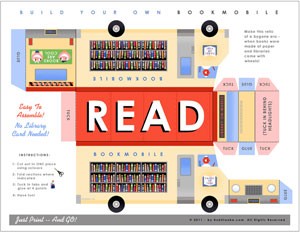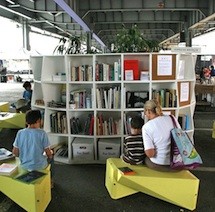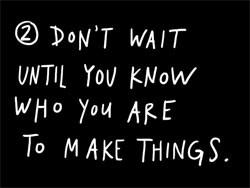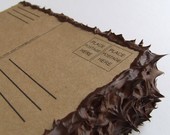 Click here to get a build your own 3-d bookmobile.
Click here to get a build your own 3-d bookmobile.
 Click here to get a build your own 3-d bookmobile.
Click here to get a build your own 3-d bookmobile.
 An article on the NPR blog, Hard Choices: Do Libraries Really Destroy Books?, has resulted in a smattering of comments on the Book Arts Listserv recently. The article, by Linda Holmes, starts
An article on the NPR blog, Hard Choices: Do Libraries Really Destroy Books?, has resulted in a smattering of comments on the Book Arts Listserv recently. The article, by Linda Holmes, starts
Yesterday, an Australian blogger named S Peter Davis wrote a piece for Cracked (the surprisingly interesting online offshoot of the old comedy print magazine) called 6 Reasons We’re In Another ‘Book-Burning’ Period In History. It’s not about the destruction of books based on content or community objections; it’s about the destruction of books because libraries (and sometimes bookstores) don’t know what to do with them, or don’t know what to do with them that makes economic sense…
Having recently spent a lot of time thinning out my own belongings, I quite sympathize with libraries. Especially about getting rid of books that are out-of-date. That’s when I happened upon Awful Library Books, a site started by two librarians as
a collection of library holdings that we find amusing and maybe questionable for libraries trying to maintain a current and relevant collection…Our criteria for inclusion of titles are simply anything that amuses us. None of the books presented are particularly awful (okay, maybe some are). These books are just odd, outdated or maybe should be reconsidered under a current interpretation of collection policies.
 There wasn’t a library in the town where I went to elementary school. Instead we would use the book mobile — a library inside a bus that periodically came to town. It was exciting when the city eventually built a library, and it became a hub for the community, providing a place for meetings and studying as well as reading and reference material.
There wasn’t a library in the town where I went to elementary school. Instead we would use the book mobile — a library inside a bus that periodically came to town. It was exciting when the city eventually built a library, and it became a hub for the community, providing a place for meetings and studying as well as reading and reference material.
![]() The Uni Project is an attempt to create communities by “temporarily transform(ing) almost any available urban space into a public reading room and venue for learning. We start with the conviction that books and learning should be prominent, accessible, and part of what we expect at street-level in our cities.” They want to augment what libraries do
The Uni Project is an attempt to create communities by “temporarily transform(ing) almost any available urban space into a public reading room and venue for learning. We start with the conviction that books and learning should be prominent, accessible, and part of what we expect at street-level in our cities.” They want to augment what libraries do
Materials in the Uni are for browsing only and do not circulate. Areas of focus are children’s picture books, poetry, short works, art books, and reference titles. Special “curated” collections rely on the physical constraint of the 16″ cubes to provide concise, in-depth looks at various ideas or topics. Whenever possible, these cubes are curated by an individual who loves books and is deeply knowledgeable and passionate about a particular subject. For example, one curator is working on a cube dedicated to the origins, history, and use of knots—this cube will include a rope and cleat board for practicing basic bends, cleats, and hitches. Another is developing a cube on deafness and sound. Cubes may also be curated by an organization. Curated collections convey a sense of passion and depth too often missing from content chosen for public space. They also serve to include different “voices” in the collection, reflecting the communities where the Uni operates.
They’ve deployed one example in lower Manhattan. You can find out more about the project here, see their kickstarter campaign here. The idea for the Uni Project came out of Street Lab.
 On his blog, Austin Kleon (who I wrote about previously here — he makes newspaper blackout poetry) has posted a talk he gave How to Steal Like An Artist (and 9 other things nobody told me), explaining how his creativity works or a “list of 10 things I wish I’d heard when I was in college.” (First seen here.)
On his blog, Austin Kleon (who I wrote about previously here — he makes newspaper blackout poetry) has posted a talk he gave How to Steal Like An Artist (and 9 other things nobody told me), explaining how his creativity works or a “list of 10 things I wish I’d heard when I was in college.” (First seen here.)
 Elissa Campbell of Blue Roof Designs attended the Focus on the Book Arts Conference last June, and wrote a report of Laura Russell’s keynote, Marketing 101 for Book Artists. Russell is the owner of 23 Sandy Gallery, and her blog, in addition to talking about work at the gallery, has articles on getting artwork into gallery and photographing artist’s books.
Elissa Campbell of Blue Roof Designs attended the Focus on the Book Arts Conference last June, and wrote a report of Laura Russell’s keynote, Marketing 101 for Book Artists. Russell is the owner of 23 Sandy Gallery, and her blog, in addition to talking about work at the gallery, has articles on getting artwork into gallery and photographing artist’s books.
 While I would prefer to communicate solely by email, my friends don’t always oblige. Some want to use Skype, some only by phone, some only postal mail. I’m not so good with handwriting letters, as my writing gets worse and worse as time goes by, and there’s no spell check. My mom, in particular, prefers cards and letters. Recently I saw this 3-D cake postcard that I thought she would particularly enjoy.
While I would prefer to communicate solely by email, my friends don’t always oblige. Some want to use Skype, some only by phone, some only postal mail. I’m not so good with handwriting letters, as my writing gets worse and worse as time goes by, and there’s no spell check. My mom, in particular, prefers cards and letters. Recently I saw this 3-D cake postcard that I thought she would particularly enjoy.